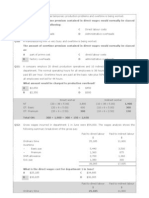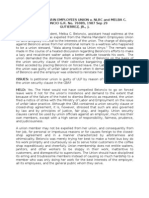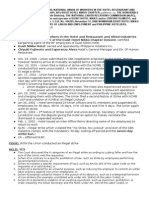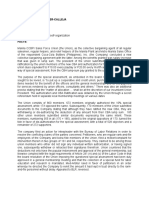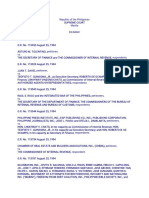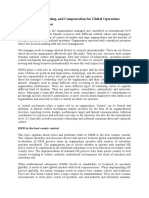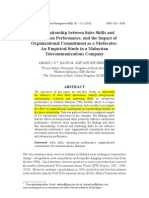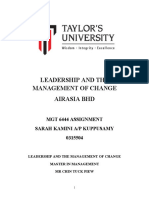University of The Philippines vs. Ferrer-Calleja
University of The Philippines vs. Ferrer-Calleja
Uploaded by
Tia RicafortCopyright:
Available Formats
University of The Philippines vs. Ferrer-Calleja
University of The Philippines vs. Ferrer-Calleja
Uploaded by
Tia RicafortOriginal Title
Copyright
Available Formats
Share this document
Did you find this document useful?
Is this content inappropriate?
Copyright:
Available Formats
University of The Philippines vs. Ferrer-Calleja
University of The Philippines vs. Ferrer-Calleja
Uploaded by
Tia RicafortCopyright:
Available Formats
USA College of Law
RICAFORT 2-D
Case Name UNIVERSITY OF THE PHILIPPINES vs. FERRER-CALLEJA
Topic Factors that determine appropriate Bargaining Unit
Case No. | Date G.R. No. 96189/211 SCRA 451 | July 14, 1992
Ponente Narvasa, C.J.
An appropriate "bargaining unit" SHOULD be comprised of all or less than all of the entire body
Doctrine of employees having substantial or mutual interests in wages, hours, working conditions and
other subjects of collective bargaining.
RELEVANT FACTS:
The "Organization of Non-Academic Personnel of UP" (ONAPUP), comprising of non-academic personnel of
UP-Diliman, Los Baños, Manila, and Visayas filed a petition in the BLR seeking a certification election among
all said non-academic employees of the University.
The "All UP Workers' Union”, whose members cover both academic and non-academic personnel, declared
its assent provided the appropriate organizational unit was first clearly defined.
The University said that there should be two (2) unions: one for academic, the other for non-academic or
administrative personnel.
However, BLR Director Calleja declared that the appropriate organizational unit should embrace ALL the
regular rank-and-file employees, teaching and non-teaching, of the University and commanded that a
certification election be "conducted among rank-and-file employees, teaching and non-teaching".
Subsequently, the University filed a Manifestation seeking the exclusion from the organizational unit of
those employees holding supervisory positions among non-academic personnel, and those in teaching staff
with the rank of Assistant Professor or higher.
ONAPUP did not oppose while the "All UP Workers' Union" did.
However, BLR Director Calleja held that they are rank and file employees since that the policy-making
powers of the Council they belong to are limited to academic matters while the policy-determining functions
contemplated in the definition of a high-level employee pertain to managerial, executive, or organization
policies.
ISSUE: W/N there should be two separate bargaining units in the University.
RULING:
YES. Having two separate bargaining units, the first consisting of the rank-and-file non-academic personnel, and
the second, of the rank-and-file academic employees, is the set-up that will best assure to all the employees the
exercise of their collective bargaining rights.
In Democratic Labor Association vs. Cebu Stevedoring Company, Inc, the basic test in determining the proper
collective bargaining unit was the use of the "community or mutuality of interests" test which mandates
examination of whether or not such unit affects a grouping of employees who have substantial, mutual interests
in wages, hours, working conditions and other subjects of collective bargaining.
In the case at bar, the University employees can easily be categorized into the aforementioned two general
classes. It is obvious that academic personnel would find very little in common with the non-academic personnel
as regards responsibilities and functions, working conditions, compensation rates, social life and interests, skills
and intellectual pursuits, cultural activities, etc. The dichotomy of interests, the dissimilarity in the nature of the
work and duties as well as in the compensation and working conditions of the academic and non-academic
personnel dictate the separation of these two categories of employees for purposes of collective bargaining.
RULING
MODIFIED. The non-academic rank-and-file employees of the University of the Philippines shall constitute a
bargaining unit to the exclusion of the academic employees of the institution.
You might also like
- Due Diligence Report TemplateDocument18 pagesDue Diligence Report Templatequynhanhle85100% (8)
- Hil Malatino. Trans CareDocument58 pagesHil Malatino. Trans CareBru PereiraNo ratings yet
- Final Submission 2Document22 pagesFinal Submission 2Guermazi DjoiNo ratings yet
- Technician - Performance Evaluation TemplateDocument1 pageTechnician - Performance Evaluation Templatebanigx0x50% (2)
- IBISWorld Executive Summary Landscaping Services in The USDocument6 pagesIBISWorld Executive Summary Landscaping Services in The USScott LeeNo ratings yet
- IMMI Grant NotificationDocument5 pagesIMMI Grant NotificationStacy KestwickNo ratings yet
- Mindanao Terminal and Brokerage Service (Mtbsi) Vs Roldan-Confesor G.R. No. 111809. May 5, 1997Document1 pageMindanao Terminal and Brokerage Service (Mtbsi) Vs Roldan-Confesor G.R. No. 111809. May 5, 1997NC BergoniaNo ratings yet
- 01 San Miguel Foods, Inc. v. San Miguel Corporation Employees Union-PTGWODocument2 pages01 San Miguel Foods, Inc. v. San Miguel Corporation Employees Union-PTGWOMikhel BeltranNo ratings yet
- ACCA F2 Labour Costs ADocument2 pagesACCA F2 Labour Costs Atracyghl2011100% (8)
- Fortune of Africa 100 IdeasDocument17 pagesFortune of Africa 100 IdeasJoelLadjoNo ratings yet
- 04 UP Vs Ferrer-CallejaDocument2 pages04 UP Vs Ferrer-CallejaJanno Sangalang100% (2)
- UP Vs Ferrer-CallejaDocument5 pagesUP Vs Ferrer-CallejaGRNo ratings yet
- Up VS Ferrer-Calleja DigestDocument4 pagesUp VS Ferrer-Calleja DigestJazztine ArtizuelaNo ratings yet
- PT & T v. LaguesmaDocument2 pagesPT & T v. Laguesmadiv_macNo ratings yet
- La Suerte Cigar & Cigarette Factory v. Director of BLRDocument2 pagesLa Suerte Cigar & Cigarette Factory v. Director of BLRanntomarong100% (1)
- 110 SMC V NLRC 1999 (Jose)Document2 pages110 SMC V NLRC 1999 (Jose)TheodoreJosephJumamilNo ratings yet
- Pagkakaisa NG Manggagawa Sa Triumph International Vs CallejaDocument1 pagePagkakaisa NG Manggagawa Sa Triumph International Vs CallejaKat JolejoleNo ratings yet
- PHILIPPINE SKYLANDERS v. NLRC (G.R. No. 127374. January 31, 2002.)Document1 pagePHILIPPINE SKYLANDERS v. NLRC (G.R. No. 127374. January 31, 2002.)Emmanuel Alejandro YrreverreIiiNo ratings yet
- Franklin Baker Co. Vs TrajanoDocument1 pageFranklin Baker Co. Vs Trajanolilnightrain100% (1)
- Manila Mandarin v. NLRCDocument1 pageManila Mandarin v. NLRCAnonymous Xkzaifvd100% (1)
- GENERAL RUBBER Case DigestDocument3 pagesGENERAL RUBBER Case DigestCeline Cabading100% (1)
- NUWHRAIN-Manila Pavilion Hotel Chapter v. SecretaryDocument2 pagesNUWHRAIN-Manila Pavilion Hotel Chapter v. SecretaryJulia Camille RealNo ratings yet
- Tropical Hut Employees' Union-CGW v. Tropical Hut Food Market, Inc. and NATUDocument1 pageTropical Hut Employees' Union-CGW v. Tropical Hut Food Market, Inc. and NATUjodelle110% (2)
- Solidbank Corporation v. GamierDocument2 pagesSolidbank Corporation v. GamierJoanne MacabagdalNo ratings yet
- Biflex Phils Union vs. FilflexDocument2 pagesBiflex Phils Union vs. FilflexjoNo ratings yet
- Philippine Skylanders, Inc. Vs NLRC DigestDocument2 pagesPhilippine Skylanders, Inc. Vs NLRC DigestSyElfredG100% (1)
- Nuwhrain V CADocument2 pagesNuwhrain V CAZoe VelascoNo ratings yet
- Sanyo vs. Canizares Digest & FulltextDocument9 pagesSanyo vs. Canizares Digest & FulltextBernie Cabang PringaseNo ratings yet
- SMC VS Laguesma Tests To Determine Bargaining UnitDocument2 pagesSMC VS Laguesma Tests To Determine Bargaining UnitBernadette Luces BeldadNo ratings yet
- Kapatiran Sa Meat and Canning Division v. Ferrer-CallejaDocument1 pageKapatiran Sa Meat and Canning Division v. Ferrer-CallejaAnonymous 5MiN6I78I0100% (1)
- 100 Heritage Hotel v. SOLEDocument2 pages100 Heritage Hotel v. SOLEclarence esguerraNo ratings yet
- MINDANAO TERMINAL BROKERAGE SERVICES vs. ROLDAN-CONFESORDocument1 pageMINDANAO TERMINAL BROKERAGE SERVICES vs. ROLDAN-CONFESORMigel DemdamNo ratings yet
- Liwayway Publications v. Permanent Concrete Workers UnionDocument2 pagesLiwayway Publications v. Permanent Concrete Workers UnionShandrei Guevarra100% (1)
- T and H Shopfitters v. T and H Shopfitters Gin Queen Workers Union DigestDocument4 pagesT and H Shopfitters v. T and H Shopfitters Gin Queen Workers Union DigestkathrynmaydevezaNo ratings yet
- Lepanto Consolidated Mining Company vs. Lepanto Capataz UnionDocument2 pagesLepanto Consolidated Mining Company vs. Lepanto Capataz UnionSecret BookNo ratings yet
- Gold City Integrated Port Service Inc. v. NLRCDocument5 pagesGold City Integrated Port Service Inc. v. NLRCRomarie AbrazaldoNo ratings yet
- Labor DigestDocument43 pagesLabor DigestKling KingNo ratings yet
- HSBC Union vs. NLRCDocument2 pagesHSBC Union vs. NLRCLino Viadnes50% (2)
- B.14 Pines V NLRCDocument13 pagesB.14 Pines V NLRCAprilMartelNo ratings yet
- Liberty Cotton Mills Workers Union vs. Liberty Cotton MillsDocument3 pagesLiberty Cotton Mills Workers Union vs. Liberty Cotton MillsFrancis PunoNo ratings yet
- Nagkahiusang Manggagawa Sa Cuison Hotel-National Federation of Labor v. LibronDocument6 pagesNagkahiusang Manggagawa Sa Cuison Hotel-National Federation of Labor v. LibronAnnie Herrera-LimNo ratings yet
- SMC Vs NLRCDocument2 pagesSMC Vs NLRCMavic Morales100% (1)
- The Heritage Hotel Manila (Owned and Operated by Grand Plaza Hotel Corporation) PetitionerDocument2 pagesThe Heritage Hotel Manila (Owned and Operated by Grand Plaza Hotel Corporation) PetitionerBon BonsNo ratings yet
- Fifth Batch - Wise and Co., Inc. vs. Wise & Co., Inc. Employees Union-NatuDocument1 pageFifth Batch - Wise and Co., Inc. vs. Wise & Co., Inc. Employees Union-NatuAngelReaNo ratings yet
- Case Digest - Golden Farms Vs Sec of LaborDocument1 pageCase Digest - Golden Farms Vs Sec of LaborRoland de la Cruz100% (3)
- Abs CBN Supervisors Union Vs Abs CBN DigestDocument2 pagesAbs CBN Supervisors Union Vs Abs CBN DigestRoland de la CruzNo ratings yet
- (Digest) Bankard Employees Vs NLRC and Bankard Inc.Document2 pages(Digest) Bankard Employees Vs NLRC and Bankard Inc.Liaa AquinoNo ratings yet
- Hacienda Fatima V National Federation of Sugarcane Workers DigestDocument1 pageHacienda Fatima V National Federation of Sugarcane Workers DigestGnNo ratings yet
- Palacol v. Ferrer-Calleja G.R. No. 85333 February 26, 1990Document2 pagesPalacol v. Ferrer-Calleja G.R. No. 85333 February 26, 1990mjpjore100% (1)
- Mariwasa Siam Ceramics, Inc. v. The Secretary of The Department of Labor and EmploymentDocument1 pageMariwasa Siam Ceramics, Inc. v. The Secretary of The Department of Labor and Employmentralph_atmosferaNo ratings yet
- Steel Corporation Vs SCP Employees UnionDocument3 pagesSteel Corporation Vs SCP Employees UnionDustin NitroNo ratings yet
- Grand Boulevard Hotel v. Genuine Labor OrganizationDocument2 pagesGrand Boulevard Hotel v. Genuine Labor OrganizationAnonymous 5MiN6I78I0100% (1)
- 099 Alabang Country Club V NLRC (2008)Document3 pages099 Alabang Country Club V NLRC (2008)Samantha Ann T. TirthdasNo ratings yet
- 07 St. Lukes Medical Center V SanchezDocument2 pages07 St. Lukes Medical Center V SanchezAnjo BeaNo ratings yet
- LABOR Digest Cases 8-42Document15 pagesLABOR Digest Cases 8-42EA100% (1)
- CENECO Vs Secretary of DOLEDocument2 pagesCENECO Vs Secretary of DOLEJanno SangalangNo ratings yet
- Mechanical Dept. Labor Union Sa PNR V CIRDocument1 pageMechanical Dept. Labor Union Sa PNR V CIRCharity PedrajasNo ratings yet
- Nagkahiusang Manggagawa Sa Cuizon Hotel v. Libron CaseDocument2 pagesNagkahiusang Manggagawa Sa Cuizon Hotel v. Libron CaseJosh BersaminaNo ratings yet
- Liwayway Publications, Inc. v. Permanent Concrete Workers UnionDocument13 pagesLiwayway Publications, Inc. v. Permanent Concrete Workers UnionAnnie Herrera-LimNo ratings yet
- Facts: Consequently, Whether Their Dismissal Due To Abandonment Was LawfulDocument2 pagesFacts: Consequently, Whether Their Dismissal Due To Abandonment Was LawfulBryan ManlapigNo ratings yet
- San Miguel Corporation Employees Union-Philippine Transport and General Workers Organization v. San Miguel Packaging Products Employees UnionPambansang Diwa NG Manggagawang PilipinoDocument2 pagesSan Miguel Corporation Employees Union-Philippine Transport and General Workers Organization v. San Miguel Packaging Products Employees UnionPambansang Diwa NG Manggagawang PilipinoJulia Camille RealNo ratings yet
- St. James School of Quezon City vs. Samahang Manggagawa Sa St. James School of Quezon CityDocument2 pagesSt. James School of Quezon City vs. Samahang Manggagawa Sa St. James School of Quezon CityG F100% (1)
- LaborDocument32 pagesLaborEmer MartinNo ratings yet
- Ramirez - Erwin Reyes v. NLRCDocument2 pagesRamirez - Erwin Reyes v. NLRCJay RamirezNo ratings yet
- Manila Cordage Company V CIR G.R. No. L 25943 January 30 1971 DigestDocument2 pagesManila Cordage Company V CIR G.R. No. L 25943 January 30 1971 DigestNEWBIENo ratings yet
- National Union of Workers in Hotels Vs Sec of LaborDocument2 pagesNational Union of Workers in Hotels Vs Sec of LaborPaolo100% (1)
- UP V Ferrer-CallejaDocument19 pagesUP V Ferrer-CallejaAnonymous WDEHEGxDhNo ratings yet
- CASE #6 DigestDocument17 pagesCASE #6 DigestDJabNo ratings yet
- Tolentino v. Secretary of FinanceDocument198 pagesTolentino v. Secretary of FinanceTia RicafortNo ratings yet
- Luzon Devt. Bank v. Assoc of Luzon Devt Bank EmployeesDocument5 pagesLuzon Devt. Bank v. Assoc of Luzon Devt Bank EmployeesTia RicafortNo ratings yet
- Balicas v. Fact Finding and Intelligence BureauDocument10 pagesBalicas v. Fact Finding and Intelligence BureauTia RicafortNo ratings yet
- Preclaro v. SandiganbayanDocument18 pagesPreclaro v. SandiganbayanTia RicafortNo ratings yet
- 13 Free Telephone Workers Union vs. PLDTDocument4 pages13 Free Telephone Workers Union vs. PLDTTia RicafortNo ratings yet
- 10 Consteel vs. IACDocument2 pages10 Consteel vs. IACTia RicafortNo ratings yet
- Structural Rubber Products Co. v. Park Rubber Co.,749 F.2d 707,715-16, 223 U.S.P.Q. (BNA) 1264 (Fed. Cir. 1984)Document21 pagesStructural Rubber Products Co. v. Park Rubber Co.,749 F.2d 707,715-16, 223 U.S.P.Q. (BNA) 1264 (Fed. Cir. 1984)Tia RicafortNo ratings yet
- Graham v. John Deere Co., 383 U.S. 1Document15 pagesGraham v. John Deere Co., 383 U.S. 1Tia RicafortNo ratings yet
- Structural Rubber Products Co. v. Park Rubber Co.,749 F.2d 707,715-16, 223 U.S.P.Q. (BNA) 1264 (Fed. Cir. 1984)Document21 pagesStructural Rubber Products Co. v. Park Rubber Co.,749 F.2d 707,715-16, 223 U.S.P.Q. (BNA) 1264 (Fed. Cir. 1984)Tia RicafortNo ratings yet
- Sison Olano v. Lim Eng CP (2016)Document9 pagesSison Olano v. Lim Eng CP (2016)Tia RicafortNo ratings yet
- ABS-CBN v. Phil. Multi-Media, G.R. Nos. 175769-70, Jan 19, 2009Document11 pagesABS-CBN v. Phil. Multi-Media, G.R. Nos. 175769-70, Jan 19, 2009Tia RicafortNo ratings yet
- Smith Kline Beckman vs. CA, G.R. No. 126627 (2003) )Document5 pagesSmith Kline Beckman vs. CA, G.R. No. 126627 (2003) )Tia RicafortNo ratings yet
- COMPETENCY MAPPING AS A TOOL FOR PERFORMANCE ENHANCEMENT (Ankita Dave H-12)Document14 pagesCOMPETENCY MAPPING AS A TOOL FOR PERFORMANCE ENHANCEMENT (Ankita Dave H-12)Nikita AroraNo ratings yet
- The Bank of KhyberDocument76 pagesThe Bank of KhyberWaqas KhanNo ratings yet
- Case Study 2Document9 pagesCase Study 2AnimeMusicTMNo ratings yet
- Chargeman BO JDDocument2 pagesChargeman BO JDamirNo ratings yet
- Staffing, Training, and Compensation For Global Operations: The Organizational ContextDocument4 pagesStaffing, Training, and Compensation For Global Operations: The Organizational ContextMakmur PanjaitanNo ratings yet
- Gepco 100609154629 Phpapp02Document60 pagesGepco 100609154629 Phpapp02SyedAshirBukhariNo ratings yet
- Activation Sports Rights Sports Centre de Bongerd (SCB)Document2 pagesActivation Sports Rights Sports Centre de Bongerd (SCB)Apriana VinasyiamNo ratings yet
- May 2015Document16 pagesMay 2015Pumper TraderNo ratings yet
- Sales SkillsDocument31 pagesSales SkillsUmair Gurmani100% (1)
- GP ReportDocument99 pagesGP ReportshainamandalNo ratings yet
- Worker Participation in ManagementDocument11 pagesWorker Participation in ManagementJg VilashNo ratings yet
- Chapter 4 Child LaborDocument2 pagesChapter 4 Child LaborAngel Agriam100% (1)
- Project Manager Resume SampleDocument2 pagesProject Manager Resume SampleDun Kioko100% (1)
- 11 Chapter 2Document86 pages11 Chapter 2Jaya BhasinNo ratings yet
- 2 Labor Law Justice Leonen Case DigestsDocument34 pages2 Labor Law Justice Leonen Case DigestsPonkan BNo ratings yet
- Leadership Air Asia FINAL SK PDFDocument15 pagesLeadership Air Asia FINAL SK PDFMuhamad DanielNo ratings yet
- GeM Bidding 4999382Document7 pagesGeM Bidding 4999382Rover Sec.No ratings yet
- Data Overview - Pse Mail Processing Clerk - Los Angeles CA Nc10015350Document3 pagesData Overview - Pse Mail Processing Clerk - Los Angeles CA Nc10015350watermelontacoNo ratings yet
- Application For Residence GuideDocument20 pagesApplication For Residence GuideConrad SambatNo ratings yet
- Sbi Po 2Document6 pagesSbi Po 2Chaitanya Kumar JinkaNo ratings yet
- House Hearing, 109TH Congress - The Economic Outlook and Current Fiscal IssuesDocument53 pagesHouse Hearing, 109TH Congress - The Economic Outlook and Current Fiscal IssuesScribd Government DocsNo ratings yet
- Project in A Matrixed OrganizationDocument9 pagesProject in A Matrixed OrganizationTasnim SheikhNo ratings yet








